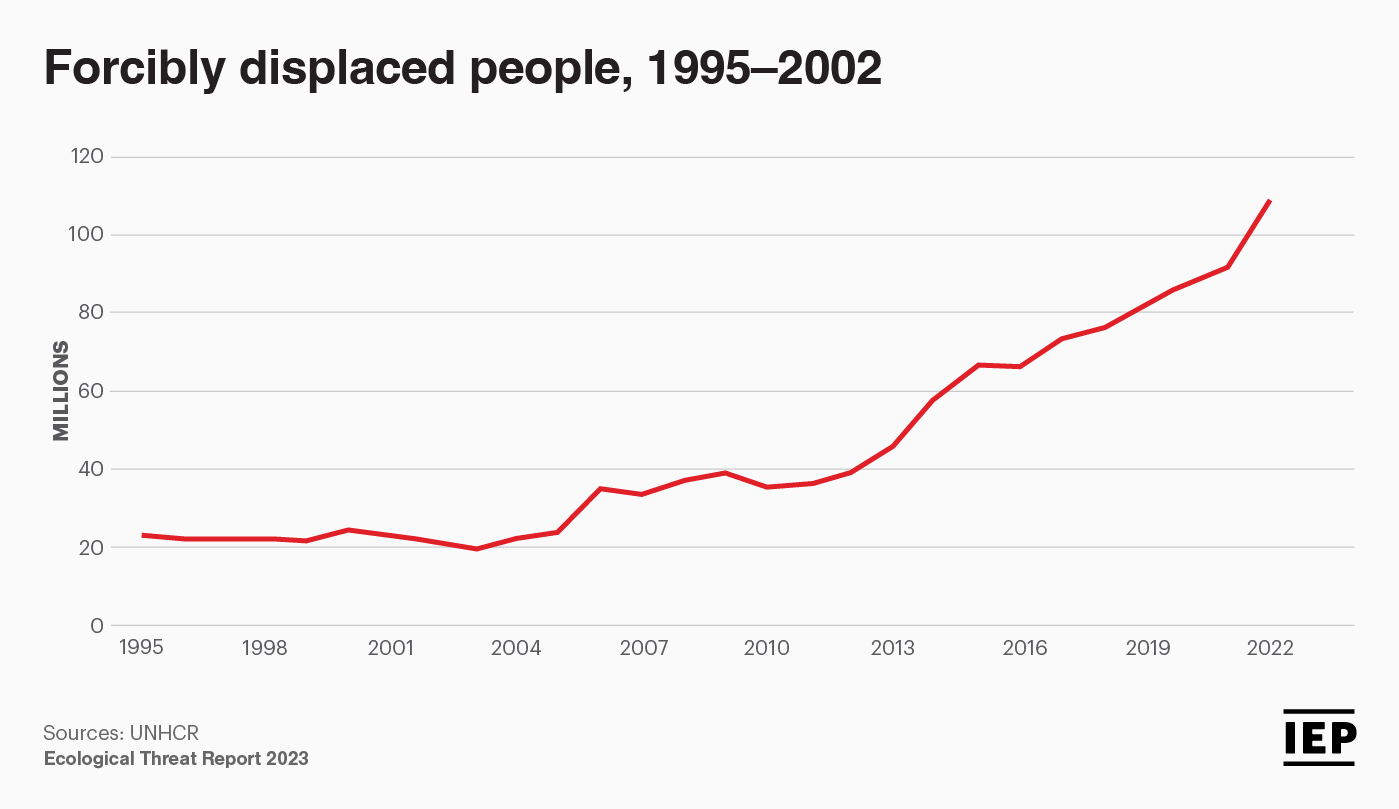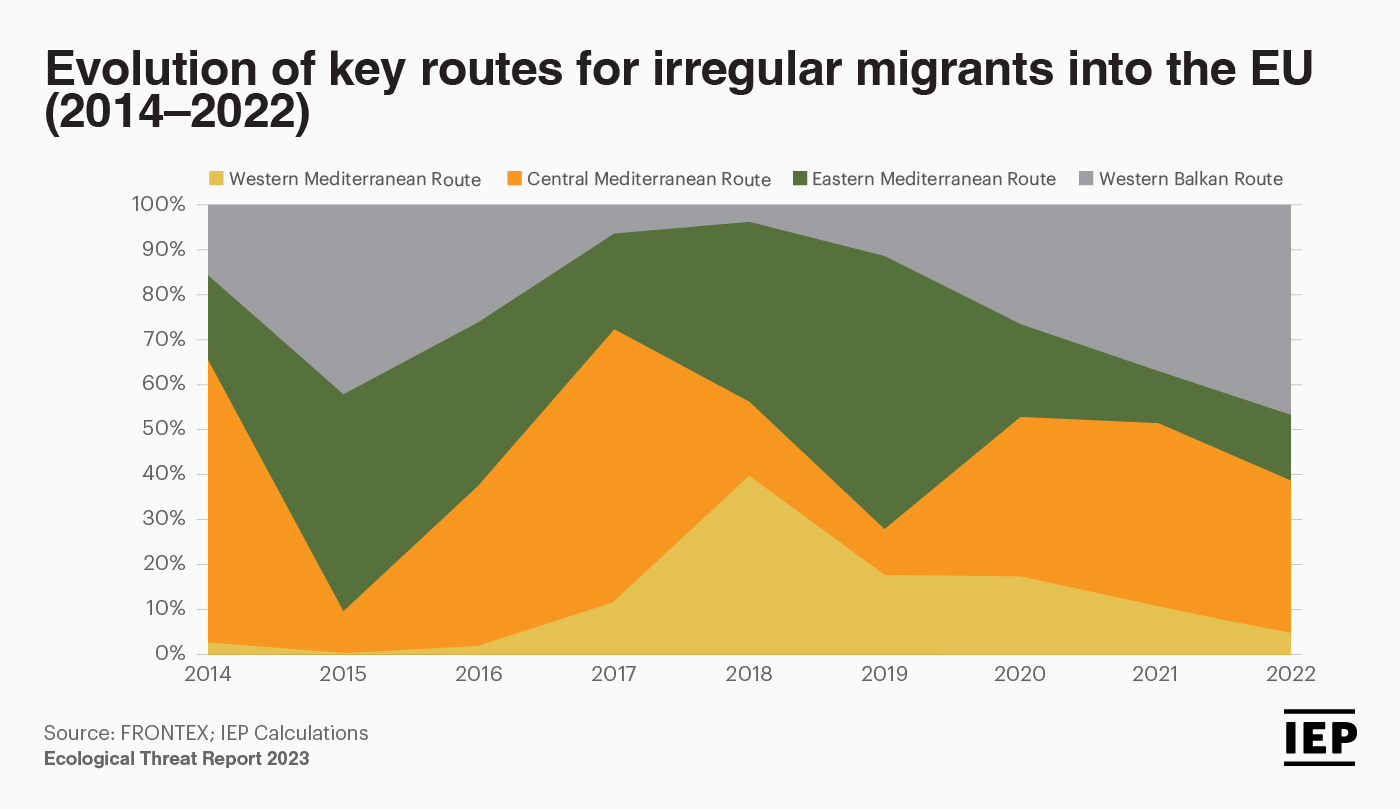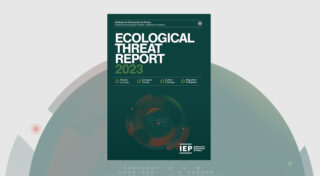In the latest release of the 2023 Ecological Threat Report, future trends of migration have been accounted for due to rising population growth in Africa, as well as refugees from the Middle East and other conflict affected areas such as Ukraine. Migration is an important effect to consider in the growing list of ecological threats.
The term forced migration includes refugees and internally displaced people (IDP), and for individuals to be considered as such, there needs to be an element that coerces or forces them into leaving. The two main causes are either climate induced migration or conflict induced migration. The line between these two become blurred as humans can induce climate crises; and conflict can occur as a result of aggressive competition for natural resources. This is explored further in the newest ETR.
Some of the key drivers of forced migration includes water scarcity and food insecurity, and these can be compounded by natural disasters such as droughts, floods and earthquakes due to worsening climate change effects. The most vulnerable region is sub-Saharan Africa, but other countries with low resilience like Middle East and North Africa (MENA) are soon to follow.

Natural disasters like typhoons and earthquakes are seen to have devastating effects on communities around the world. The victims of such are forced to leave their homes and usually move towards urban areas. The smoke from the wildfires that occurred in Canada earlier this year crossed into the United States where the air level quality was severely affected in cities like New York and Chicago.
In Ethiopia, South Sudan and Somalia, two million people were displaced after the drought that affected the Horn of Africa. Nearly 200,000 people crossed the border into other drought affected areas like Kenya. This could lead to severe strains on their local environments’ infrastructure, food security and access to fresh water as the affected states do not have the resources to manage the influx of refugees and IDP’s.
Migration can heighten competition for jobs, housing and various resources, often serving as a catalyst for conflict when large populations migrate to urban settings. The ETR identifies several push factors in rural areas, encompassing environmental degradation, resource scarcity, conflict, and notably, rapid population growth.
Migration will affect megacities in the near future, as the number of forcibly displaced people in the world now stands at over 108 million. There are 60% of refugees and 80% of IDP’s living in urban areas. The average length of time that someone is displaced has also increased from an average of nine years in the 1990s to over two decades in 2023. Mexico City, which was built on top of a lake, currently lives with one in five people having access to tap water for only a few hours a day. This is due to inadequate management, insufficient investments in rainwater collection and the loss of freshwater.
To understand the flows of migration, exploring the physical routes and their accessibility towards refugees reveals a trend. In the European context, migration from MENA has witnessed a notable uptick. Since 2020, the EU Schengen zone has grappled with a substantial surge in illegal border crossings, a stark departure from the subdued levels observed during the COVID-19 pandemic. By 2022, the number of illegal crossings reached its peak, reminiscent of the last highest record witnessed in 2016 when individuals fled conflicts in Syria, Afghanistan and Iraq.
Over the span of two years in 2020-2022, illegal crossings into the EU Schengen zone skyrocketed by 161%, tallying a staggering 657,641 cases. Meanwhile, the FROMTEX reported a separate statistic, noting nearly 13 million Ukrainian refugees entering the EU in 2022. This figure is distinct from the statistics on illegal immigration, highlighting the multifaceted nature of migration dynamics in the region.

The primary gateways for irregular migrants entering the EU were the Eastern Mediterranean and Western Balkan routes. The Eastern Mediterranean route involved sea and land crossings primarily originating from Turkey, while the Western Balkan route consisted of land pathways from Greece into Central and Western Europe.
Although ecological threats do not serve as the primary cause of illegal crossings into the EU, they emerge as a significant secondary factor. Data from the ETR indicates that a notable portion of illegal crossings between 2020 and 2022 emanated from countries grappling with severe food and climate insecurity, rapid population growth and water risks. Collectively, individuals from Syria, Afghanistan, Tunisia, Morocco, Algeria, Egypt, Bangladesh, Turkey and Pakistan made up just over 67% of the total illegal border crossings.
The interaction between ecological threats, climate change and migration is complex. While ecological threats can exacerbate political unrest and conflicts, their direct connection to migration is multifaceted. Syria, for instance, faced severe droughts before its civil war, which intensified existing vulnerabilities, leading to unrest. Since 2009, over one million Syrians have sought refuge in the EU. Similarly, countries like Afghanistan and Bangladesh, grappling with multiple ecological challenges, have seen increased migration to the EU. The line between climate and conflict is becoming increasingly blurred, as the intermingling relationship between humans and the environment becomes more evident.

Download the Ecological Threat Report 2023
Ecological Threat Report 2023